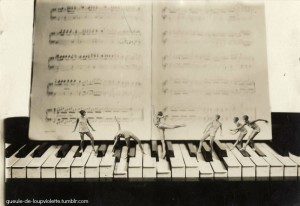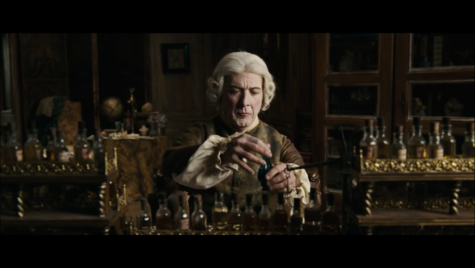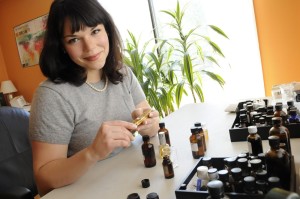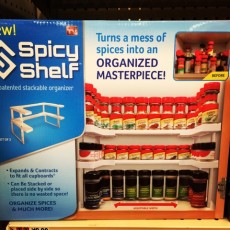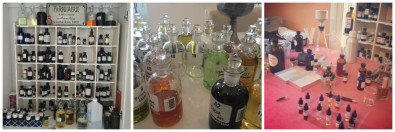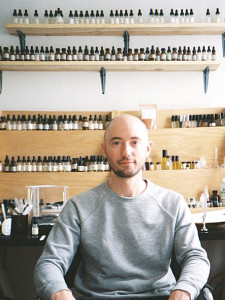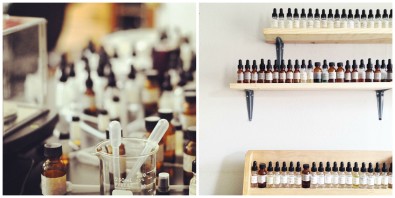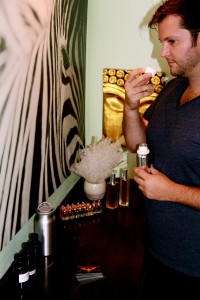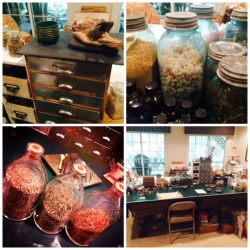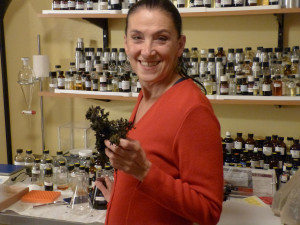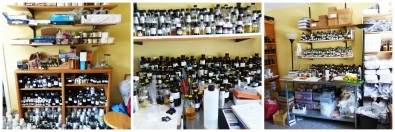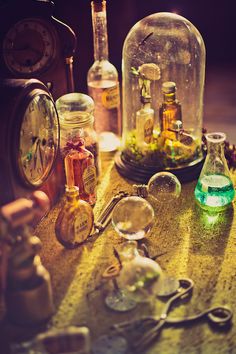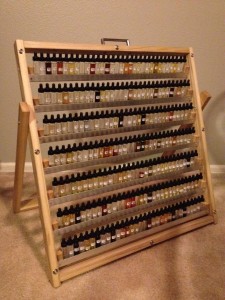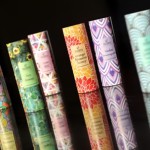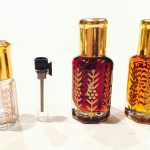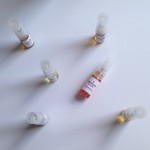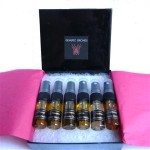Vintage Piano and Score paper (Photo: Guele-de-loupviolette.tumbler )
Imagine composing a symphony without score paper to record the notes on? The score paper is to a composer what the perfumer organ is for the perfumer, a tool that becomes invaluable and an integral part of the work and the scented choreography they compose. In our Perfumer’s Workshop, four artisan perfumers open their doors to what very few are privy to ever seeing- their perfmer organs, raw materials and works spaces.
(Dustin Hoffman) Baldini’ s perfume organ and workshop from the movie Perfume: The Story of A Murderer 2006
The perfume organ has a long tradition in perfumery and adds structure, order, and organization to what is inherently a creative process. Each perfumer has the opportunity to customize and lay out their organ in the ways that work best for their creative process. Just as these artists evolve, their perfume organs and workspaces evolve with them to continue serving their perfumer and the fragrances they create. The size, shape, groupings, and materials may change over time, but the relationship stays strong and is a beautiful partnership for success.
Charna Ethier of Providence Perfume Co.
Natural Perfumer Charna Ethier of Providence Perfume Co. has long since graduated from a simple organ, but offers helpful and creative advice for those starting out:
The tiered spice shelves can be a great starting point for a perfume organ. Three of them arranged in a C shape on your desk allow an easy and dynamic beginning. The three tiers of the shelves allow the budding perfumer to organize their materials by note or longevity. She suggests sourcing out some of the more affordable and important materials to start with and expanding from there. Some top notes Ms. Ethier recommends are bergamot, bitter orange, pink grapefruit, black pepper, rosewood, and mimosa. For middle or heart notes try rose, jasmine, and ylang ylang. The base notes of sandalwood, fir balsam, vanilla, patchouli, and vetiver make for a great jumping off point.
Charna Ethier perfume essences, workspace and organ
As time has passed, Ms. Ethier has moved from working from three wooden trays sorted by notes to a much more elaborate desk filled with jewels of fragrance decanted into vintage Wheaton lab glass bottles with stoppers and arranged on three large shelves. Due to a recent fire that severely damaged her store in Providence, RI, Charna was unable to show us her current layout and perfume organ. She was kind enough to take the time away from reconstruction to share her wealth of experience and allow us a peek at one of her recent perfume organs.
Hans Hendley of Hendley Perfumes
For Hans Hendley of Hendley Perfumes, building a work space and library of materials has been one of the most enjoyable , most costly, and important facets of his journey as a perfumer. It’s taken him years to obtain a collection of raw materials and understand how to work with them. This time has allowed him to explore and learn how he works best.
Hans Hendley’s Perfume Organ, Workspace
Since space has been a limited commodity for Mr. Hendley, (who lives in Brooklyn) he has become a master of multi-purposing his space and organizes it according what he is doing during that particular work session; from evaluating new materials to exploring combinations and accords, to refining and finishing his creations. With a goal for the session in mind, he brings out the materials and tools that will best serve him in the task and arranges them on his organ accordingly. As he gets swept away in the creative process, he often finds himself pulling out a bottle and creating different dilutions of a material, ending with a much busier workspace than he started with. Mr. Hendley utilizes both natural and man-made materials in his perfumes, most pre-diluted to 10% in alcohol, allowing him to better evaluate them and get a closer sense of what the concentrations will be need for the final perfume. Both natural and man-made materials are side by side on the perfume organ, grouped into clusters that make sense to him as far as what the materials do, or where they might fit into the ideas he is focusing on and much of composition occurs cerebrally before working on anything physically at the perfumer’s organ. He finds that ultimately the process is fluid and constantly unfolding.
JK DeLapp of The Rising Phoenix
Natural Perfumer JK DeLapp of The Rising Phoenix Perfumery keeps an apothecary close at hand, and has creatively repurposed a pool and ping pong table to serve as his playing field where he drafts his olfactive creations.
JK DeLapp’s Japanese Sochu bottles, Antique Bottles, Workspace and Perfumer’s Organ
Mr. DeLapp uses a few different methods for organizing his materials. He primarily sorts by note and alphabetically. He organizes frequently used materials in towers on the tables. He keeps less often used items in storage bins arranged according to notes first, then by scent groups such as Narcotic/ Floral, Spice, Resin, Wood, Herbal/Camphoraceous, etc. Because Mr. DeLapp creates incense as well as perfumes, he keeps an assortment of botanicals and incense ingredients nearby. He stores these in a variety of antique Ball jars and used Japanese Sochu bottles to make for a beautiful presentation. Again dividing his materials into a few categories, those used often are arranged nicely on top of the ingredients towers. The rest are kept in bins under the desks and arranged into categories such as Wood Powders, Agarwood Powders, Raw Agarwood Chips, Sandalwood Powders and Chips, Japanese Ingredients, Resins, Herbs, and Spices. JK has found that creating a lovely workspace is key to enjoying your work!
Ellen Covey of Olympic Orchid Perfumes has amassed a library of scent materials so vast, she has had to grow the original perfume organ concept past a desk and expand into a full room! From the humble beginnings of a rag-tag collection of essential oils bottles arranged on one shelf, her perfume organ has evolved into an entire wall of bottles of working materials, a set of drawers full of less-used or very expensive materials in small quantities, another wall and a half of larger bulk bottles, a half wall of tinctures, and several storage areas for 1 kg bottles larger drums of materials.
Ellen Covey perfumer’s organ and workspace
Ms. Covey’s methods of working and system of organization have evolved organically along with her collection of materials. On her working organ, she uses a rough arrangement in which frequently used naturals are on the lowest 3-tiered shelf and frequently used aroma chemicals are just above them. The highest shelves have a mix of naturals and aroma chemicals used less often. All are arranged somewhat alphabetically. She also has two two-drawer chests below the desk, with natural materials filling the one on the left and aroma chemicals on the right. Ms. Covey prefers to work with her raw materials at full strength while blending and creating. She reserves a place for a lab notebook and pen, and stresses the importance of record-keeping while blending. She says that she is constantly acquiring new materials, but no matter how full her studio may be, there’s always room for one more bottle. As her collection of materials expands, her organ will expand and change in parallel.
All our perfumers stressed the importance of various laboratory tools and equipment such as digital scales, droppers or pipettes, beakers, bottles, funnels, and notebooks to aid them in their work.
Vintage Perfumes and essences
With an eclectic mix of art and science, our perfumers manage to create workspaces as individual as they are and use these spaces to bring us their amazing perfumes to enjoy. Honoring the age old traditions of perfumery and its ties to music, the perfumer’s organ lets the perfumer apply their hands and blend notes together to compose the olfactive symphonies we love.
Michael Singels Portable Perfumer Organ
Michael Singels, Senior Contributor
Thanks to the generosity of our featured perfumers, we have four draws
WORLDWIDE: Charna Ethier of Providence Perfume Co. is offering a sample set of all six of her perfume oils (Including Ivy Tower, Violet Beauregarde, Rose 802,Sweet Jasmine Brown, Summer Yuzu, Ivy Tower, and Orange Blossom Honey to one registered reader
WORLDWIDE: JK DeLapp of The Rising Phoenix is offering a sample set of five different 0.15g oud oil distillations (includes City Oud and Rose Oud reviewed here) to one registered reader.
WORLDWIDE: Hans Hendley of Hendley Perfumes is offering a discovery set that includes 2ml atomizer of each of his 6 perfumes including Auric, Gia, Fume, Jade, Rosenthal and Bourbon to one registered reader
WORLDWIDE and USA: Ellen Covey of Olympic Orchids Artisan Perfumes, (the Art and Olfaction Award Winning Artisan perfumer for Woodcut) is offering a custom discovery set to a US reader or a reader’s choice of a 5-ml travel spray to an international reader.
To be eligible, our registered readers may leave a comment below telling us what they learned about creating a perfumer’s organ, tips you picked up from each perfumer, which essences you love and would begin with, what your prize would be should you win and where you live (be very specific in the case of Olympic Orchids). Draw closes August 29, 2015
We announce the winners on our site and on our Facebook page, so Like Cafleurebon and use our RSS option…or your dream prize will be just spilled perfume

